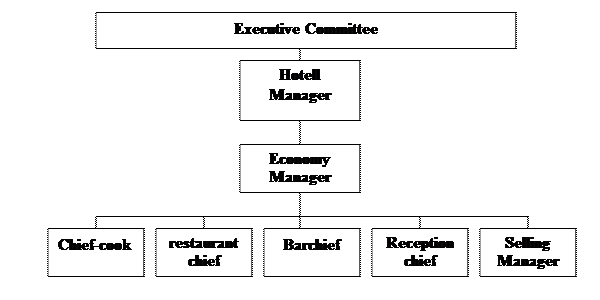Реферат: Различные стили лидерства на примере одного отеля
Early efforts to understand leadership success focused on the leader’s personal traits. In the 1990’s the “great man” theories appeared. They tried to figure out who is born to lead. They studied the great leaders of the past such as Caesar, Napoleon, and Richard III. Those days the world was stable and predictable, the societies were not so complex, the groups were few and small. The leaders acted on “macro” level and were associated with heroes. Later researches (1940’s-1950’s) tried to find the universal traits common to all leaders. There was a sense that some critical leadership traits could be isolated. There was also a feeling that people with such traits could then be recruited, selected, trained and installed into leadership positions. In their studies some traits did appear more frequently than others: technical skills, friendliness, intelligence, general charisma, drive, task motivation, application to task, social skills, emotional control, administrative skill, group-task supportiveness.
The problem with the trait approach lies in the fact that almost as many traits as studies undertaken were identified. Stogdill examined over 100 studies based on the trait approach. (Daft, R., 1999:65) He uncovered that the importance of a particular trait was often relative to another factor- the situation. Indeed, when we look at such leaders as Stalin, Hitler, Churchill, Mother Theresa, Gandhi, Martin Luther King, Jr., John Kennedy, Margareth Thatcher, do they have any traits in common all together? Having failed to identify the leader’s traits, the researchers understood that leadership is usually a more complicated process.
2.3 Behaviour approaches
The results of the trait studies were inconclusive. Researchers changed the focus from the “great men” to small groups and their leaders. Researchers turned to an examination of leader behaviours. Rather than concentrating on what leaders are, as the trait approach urged, the behavioural approach forced looking at what leaders do. This approach (1950’s-60’s) says that anyone who adopts the appropriate behaviour can be a good leader. (Daft, R., 1999:69) Behavioural patterns can be learned in contrast with traits that must be possessed.
The studies of Iowa State University were a precursor to behaviour approach. They recognised autocratic versus democratic leadership styles.
The most prominent studies were those undertaken by the University of Michigan and by Ohio State University. Interestingly, both studies concluded that leadership behaviours could be classified into two groups.
Ohio State University University of Michigan
- Initiating Structure - Production Centered task-oriented
-Consideration - Employee Centered people-oriented
Likert (the University of Michigan) found that employee-centered leader behaviour generally tended to be more effective. Blake and Mouton of the University of Texas went into the same direction and suggested the two similar dimensions: concern for people and concern for results. But they worked out the leadership grid and suggested five leadership styles:
1.1 Impoverishment Management (minimal degree of each concern). The less effective leadership.
9.1 Authority-Compliance Management (maximal degree of concern for results, minimal degree of concern for people)
5.5 Middle-of.the-Road- Management (average degree of both concerns)
1.9 Country Club Management (minimal degree of concern for results, maximal degree of concern for people)
9.9 Team Management (maximal degree of each concern). This was considered to be the most effective leadership style.
This approach goes further that trait approach by trying to group leaders into several categories instead of finding something common to all leaders. Still, leaders were supposed to have “either-or” style.
2.4. Situational (contingency) approach
Unable to determine which particular behaviour patterns consistently resulted in effective leadership, researches then attempted to match behaviour patterns that worked best in specific contexts or situations. The previous researches studied two dimensions: leaders themselves and their relationships with followers. The central focus of the new research was situation in which leadership occurred. The most important point is that the components of leadership style, subordinate characteristics and situational elements impact one another. Fiedler’s contingency model, Hersey and Blanchard’s situational theory, the path-goal theory, and substitutes for leadership each describe that different situations need different styles of leadership behaviour so that it was an effective leadership.
According to Fiedler, leaders can determine if the situation is favourable to their leadership style. Task-oriented leaders tend to do better in very easy or very difficult situations, while person-oriented leaders do best in situations of intermediate favourability. Hersey and Blanchard say that leaders can adjust their task or relationship style to accommodate the readiness level of their subordinates. The path-goal theory states that leaders can use a style that either clarifies the path to desired rewards or increases the rewards so that the followers would display increased effort and motivation. (Daft, R., 1999:114) We will have a closer look at two of these theories in our practical part.
The limits of this paper do not allow us to analyse other theories as dyadic theory, integrate and alternative approaches. But all these theories took into consideration the fact that leadership is a complex phenomenon and its effectiveness depends on many factors.
3. Implementation of the theory in practice.
3.1 Presentation of Quality Arcticus Hotel
Quality Arcticus Hotel is a typical service organisation. It is an equivalent of a four-star hotel, and a member of a hotel chain Choice Hotels. Here is an organisation plan of the hotel.


As an action company, it has a committee, consisting of 5 persons who were chosen by the personnel. In the hotel we can see a vertical power structure. One can observe three levels of leaders here:
Strategic level – the hotel manager (administrative director)
Middle level – the economy chief
Operative level – the restaurant chief, the bar chief, the chief-cook, the reception chief, and the selling manager.
I have chosen three leaders for my research: the hotel manager, the economy chief and the restaurant chief. I work at this restaurant, so I know the restaurant chief’s work best out of the operative leaders.
In connection with this paper I am interested in what kind of leader styles these three persons practice. I consider their work as very effective. To this point, the hotel has not had serious economical problems or conflicts with the personnel. I should mention that it is a small hotel, and it can be considered a family organisation.[1] Moreover, all the three were not elected to their positions and in reality can take their leader positions as long as they wish to. Such relations give more power to the leaders. However, their relationship to the personnel is very good. Their subordinates call them democratic bosses. I would like to find out what helps these leaders work effectively and keep such a good reputation. I am going to use the leader theories that I have talked about in this paper. I want to find out whether those theories are relevant when explaining the success of these three leaders.